The World's Most Advanced Copying Technology
Throughout the day, without your ever being aware of it, your cells carry out countless processes with an extraordinary care and sense of responsibility, for you to continue living in a healthy state. One of these processes is cell division, which permits growth and tissue repair. DNA's ability to be copied enables damaged tissue to repair itself by means of cells dividing and multiplying, during the course of which the original genetic information is transmitted to every new cell.
Most of the cells in the human body divide and multiply. During the course of cell division, the replication of the DNA in the cell nucleus is carried out in such an astonishingly organized and disciplined way. Even when the human embryo is no more than a single cell, it divides into two, and progressively, from two to four, to eight . . . and an exact copy of the original DNA needs to be produced for the new cell. In fact, shortly before a cell divides, DNA replicates itself and transmitsit to the new cell.
According to observations of the process, the cell has to reach a specific size before dividing. The moment this particular size is exceeded, the process of division begins in a programmed manner. The shape of the cell begins flattening out, and the DNA replicates itself.
The cell as a whole decides to divide, and the different components within it begin behaving in appropriately. Clear, however, cells by themselves are incapable of managing such a collective task. The process of division begins at Allah's command, and all the components of the cell, especially DNA, act accordingly.
The DNA molecule, with its data-bank of 3 billion letters, resembles a double spiral staircase. When the replication process begins, first an enzyme known as DNA helicase arrives and begins opening up the DNA helix, just like a zipper. As a result, the two strips of the helix, formerly wound around one another, separate. DNA helicase is always on duty at exactly the right time and performs its work flawlessly, never making a mistake that would cause any harm to the DNA.
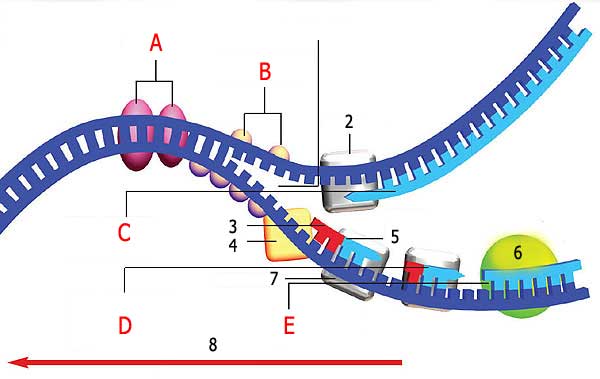 | |
| 1. Copying fork | 5. Okazaki fragments are formed |
| A) Helicases unravel the DNA helix. | |
| All the elements in DNA copying behave according to Allah's command. With the abilities bestowed on them by Allah they are able to carry out a process so perfect and essential for human life. | |
Once the DNA molecule has assumed the form of two lengthy strips, the work is now handed over to the enzyme DNA polymerase, whose job is to make provide each separated arm of the DNA with a new strip. To do this, it finds and brings in the appropriate data comprising each of the DNA strips. An enzyme made up of atoms, devoid of any consciousness or intelligence, identifies the information needed to complete the two DNA halves, and installs them accordingly. During the course of all of this, it makes not the slightest error, but completes and identifies all the 3 billion letters concerned one by one, with perfect accuracy. At this point, another polymerase enzyme completes the other half of the DNA in exactly the same way. As all this takes place, helix stabilizing enzymes hold on to the ends of the DNA to prevent the two separate strips from winding around one another again.
In this way, the two missing halves of the DNA strip are completed, using materials already found in the surrounding cell, and two new DNA molecules are produced. Expert proteins known as enzymes, working just like highly advanced robots, act in every phase of the operation. During these stages, a great many highly complex intermediate processes occur, which would also provide the subject for a book.
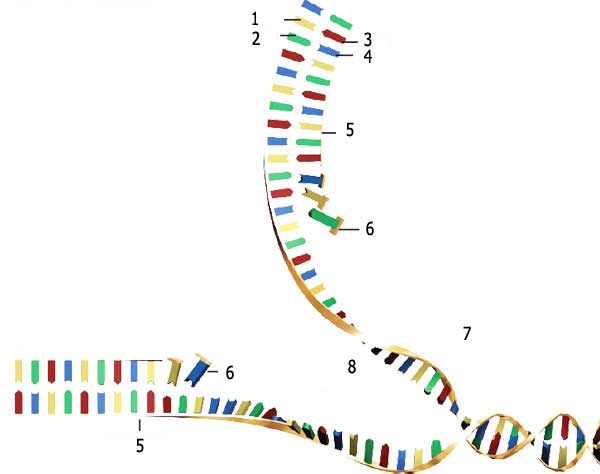 | |
| 1. Adenine | 5. Newly built strip |
| As the cell begins flattening out prior to division, the DNA also copies itself. The cell decides to divide as a whole. All the components within the cell act in accordance with that decision to divide. It is obvious that the cell itself cannot possess the ability to achieve such a collective task. Every stage in the division and copying processes takes place with the instruction to begin issued by the Lord of All. | |
The new DNA molecules that are copied are checked many times by supervising enzymes. Any error –and such errors could have lethal consequences– is immediately identified and corrected. The flawed code is extracted and the correct gene brought in and assembled.
James Watson and Francis Crick, the scientists who discovered the structure of DNA, reduced the replication process they described as a "perfect biological principle," to a very simple form. Today, however, we know that the way DNA copies itself is so complex as to amaze scientists. Twenty separate proteins and enzymes must be present for even the smallest strip of DNA to be replicated.88 Prof. Werner Gitt describes the perfection inherent in this replication:
The DNA is structured in such a way that it can be replicated every time a cell divides in two. Each of the two daughter cells must have identically same genetic information after the division and copying process. This replication is so precise . . . .89
 |
| The copying of DNA enables the cells to divide and reproduce, for damages structures to be repaired and for genetic data to be transmitted to the new cell... |
One of the most miraculous aspects of DNA replication is that unconscious is molecules carry out everything described here. Enzymes consisting of combinations of unconscious atoms identify the missing sections of the DNA helix, obtain the missing parts and install them in the right locations. No doubt, the way such minuscule structures with no consciousness or intelligence flawlessly perform processes requiring all these features exhibits the incomparable nature of Allah's creation. All these elements behave at Allah's command. With the ability bestowed on them by Him, they perform such a vitally important process for human life in the most immaculate way. The organization in Allah's creation is revealed in these terms in the Qur'an:
Does man reckon he will be left to go on unchecked? Was he not a drop of ejaculated sperm, then a blood-clot which He created and shaped,making from it both sexes, male and female? (Surah al-Qiyama, 36-39)
The Matchless Speed in Replication
All the processes involved in the replication of DNA take place at such an astonishing pace that 3,000 nucleotide steps are produced in one minute. Fifty base pairs are copied in only a second.90 Meanwhile, the enzymes responsible check all the steps many times over and make the necessary corrections.
For a better idea of the enormous speed at which the process of DNA replication occurs, the division of a cell lasts between 20 and 80 minutes, during which time the information in the DNA also must be copied and reproduced. All the 3 billion pieces of information in the DNA have to be able to be copied in between 20 and 80 minutes, with no errors, omissions or gaps. This is as miraculous as the copying an entire library of information, or 1,000 books, or a text of one million pages, in that same space of time - again with no errors or omissions.
Moreover, it is not highly advanced technological devices or highly developed photocopying machines that accomplish this, but enzymes consisting of combinations of various atoms.
Due to external factors, a great many errors may be made in the new DNA molecule produced at such a great speed. Ribosomes in the cell now begin manufacturing DNA-repair enzymes in the light of the instruction reaching them from DNA. This means that the DNA has taken the necessary steps to protect itself! Like the human beings they constitute, cells are born, multiply and die. However, the lifespan of cells is very much shorter than that of the human beings. For example, the vast majority of the cells that made up your body six months ago are no longer alive. Yet since they gradually divided and were replaced by new ones, you remain alive and well today. That is why events such as cell multiplication and the replication of DNA are so vitally important to human life and offer no room for even the slightest error.
One astonishing aspect of all this is that the enzymes that ensure the production of DNA and also supervise its structure are proteins produced at the command of that same DNA, under the control of the information contained within it. It is absolutely impossible for it to have assumed this magnificently convoluted system as the result of gradual, random coincidences, because DNA has to exist for the enzyme to appear. But also, the enzyme must exist for DNA, and all the organelles in the cell must be present to permit the existence of both.
As you can see from this summarized information, the elements in your body accomplish all their tasks successfully and completely. Allah has placed countless atoms and molecules, from the very largest to the very smallest, at our service in order for us to be able to live healthy lives. In one verse He reveals that:
… Allah pours out His favor on humanity, but most people do not show thanks. (Surah Ghafir, 61)
To whom actually belongs the intelligence and knowledge that realizes that a replication of the DNA must be made during cell division, which carry out the replication process in such a flawless manner, and which establish such a magnificent system capable of immediately rectifying processing errors? It would be completely illogical to say that such a flawless organization developed as the result of chance. Even were you to combine all the atoms in the universe, providing all the necessary conditions you could still never produce a system that carries out DNA replication by chance. It is abundantly clear that Allah, Almighty and Omniscient, created such a flawless system and has continued to maintain it for millions of years. This fact is also revealed in a verse from the Qur'an:
What is in the heavens and in the Earth belongs to Allah. Allah encompasses all things. (Surat an-Nisa, 126)
The Rectification of Copying Errors
When a cell divides, errors sometimes arise as the chromosomes replicate themselves. To prevent errors in the genetic data accumulating in subsequent generations, every living thing possesses a mechanism that identifies and corrects the great majority of these errors. Did this mechanism not exist, the genetic structure of living things would soon become impaired, and extinction would be the eventual result.
The cell also works as an editor to reduce the number of such errors, though one or two are an acceptable level. Thanks to this control mechanism, a very small level of error –between one in a billion and one in a hundred billion– remains. One error in 100 billion is the equivalent of one mistake in a text of 50 million pages. It would take 100 professional layout staff, working non-stop for their entire lives, to produce 50 million pages.91 The nuclear physicist Gerald L. Schroeder describes the intellect displayed in the quality control system in the cell:
The cleverness of the system is subtle. Not just how it learned to get a protein to open the helix, or how DNA-P is made and then knows to come on the scene, or how it finds and joins the correct base. Those acts in themselves are near wizardry and plead for explanation. The cleverness here is that each new strand winds helically with the parent from which it was, as a complement, copied. Brilliant! Now quality control proteins can check the new work directly against the original template, the parent strand. Had the two new strands wound about each other, new to new, and the two parent strands reformed their original helix, the quality control would have been a far more difficult and far less efficient task.92
The astonishingly intelligent and precautionary events take place in DNA and in all the systems that work under its instructions cannot possibly be accounted for in terms of chance. These are programmed in an ordered manner that can be explained only by the existence of a Creator, the possessor of the knowledge of all things and the Lord of all things. That Creator is Almighty Allah, Who endows us with life By His mercy, and Whose knowledge enfolds all things.
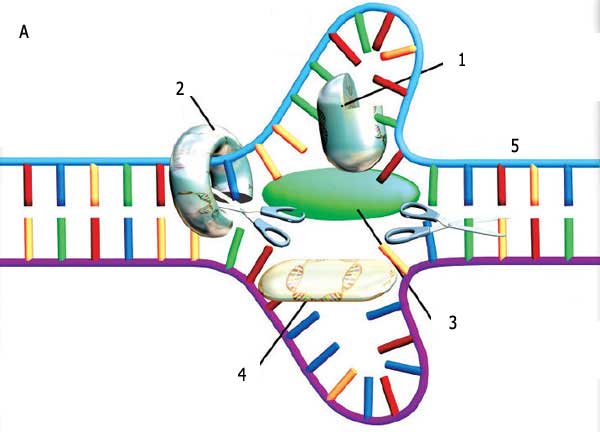 |
| 1. A special protein examines the DNA for damage repair. |
| Several proteins engage in DNA repair. Each one acts with an extraordinary cooperation and in complete harmony. |
DNA Enzymes with Their Vital Tasks
When enzymes cause a reaction, an effect arises similar to the difference between rolling a ball uphill and downhill. Enzymes are able to accelerate biochemical reactions by up to 1,000 times.93 93The human body contains more than 3,500 kinds of enzymes. In the event of the absence of even a few of them, the cell's internal activities would become completely confused. The result would impair the order existing within the cell, and the end of life. (For detailed information, see Harun Yahya's , The Miraculous Machine That Works For An Entire Lifetime: Enzyme)
One of the most important jobs of DNA enzymes is to assist with the replication of the DNA molecule. The only difference between the molecule of an enzyme and other proteins is the former's three-dimensional shape. If enzymes did not possess this three-dimensional shape setting out their own characteristics, then processes inside the cell, information sent from the brain to various organs and internal regulation of the cell would not exist. A great many processes needed to keep the cell alive could not take place. Even the absence of the enzyme that corrects errors during DNA replication could lead to the genes losing their functionality, or to flawed production leading in turn to the development of cancer.
The enzymes involved in DNAreplication include:
DNA helicase, which opens up the DNA helix like a zipper
 |
| DNA Helicase |
As you have seen, when the replication process begins, the enzyme known as DNA helicase is the first to arrive and begins opening up the DNA helix just like a zipper. As a result, the DNA's two entwined arms separate from one another. DNA helicase has the ability to open 1,000 nucleotide pairs a second.
As the DNA arms separate, helix stabilizing enzymes hold both arms to prevent them wrapping round each other once again.
As DNA helicase opens the zipper, it suddenly halts. The points where it stops set the two ends of the required information. Enzymes behave with enormous expertise, just as if they knew where the data began and ended.
DNA polymerase, the maker of new DNA strips
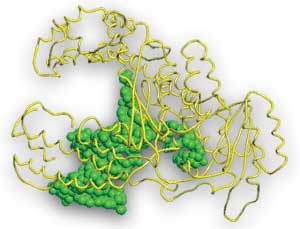 |
| DNA Polymerase |
It is now the turn of DNA polymerase whose job, as you saw earlier, is to complete the divided arms of the DNA with a second arm of each. It therefore locates and fetches information corresponding to that one arm of the DNA.
DNA polymerase produces new strips in a complete and flawless manner. Cytosine in the old strip is always combined with guanine in the new one. Adenine is always joined up with thymine, and vice versa. However, during this matching process that takes place at such high speed, a few errors are bound to arise. Opposite adenine in one location, for example, the DNA polymerase may install guanine instead of thymine. Errors of this kind can sometimes represent a lethal danger. For instance, if the sixth amino acid in the structure of hemoglobin is replaced by another known as valine, thread-like fibers will emerge in the protein and prevent erythrocytes from moving about freely, leading to the disease known as sickle cell anemia.94
Just like an editor who corrects written texts, this enzyme identifies errors in the DNA and removes the wrong letter. However, this leaves a gap in the DNA helix. Another enzyme occupies itself with that problem.
DNA nuclease, exceedingly sensitive to errors
Just like an editor who corrects written texts, this enzyme identifies errors in the DNA and removes the wrong letter. However, this leaves a gap in the DNA helix. Another enzyme occupies itself with that problem.
DNA ligase, repairing breaks in the DNA
When the DNA nuclease identifies the mistaken section and extracts it, the resulting gap in the DNA strip is repaired by an enzyme known as DNA ligase. Thanks to the perfection obtained in this very final stage, only one error in a billion nucleotides is permitted - a level of error many times superior to any data system under computer control. One error in a billion is the equivalent of making only one mistake while copying thousands of books.95 This level shows what an extraordinary regulatory mechanism is compressed into a space too small to be seen with the naked eye.
Topoisomerase: enables DNA to be unraveled without knotting
DNA strips are packed into tiny volumes many thousands of times smaller than their length. In functioning in this small space, DNA may encounter several problems because of its shape. For example, as the DNA helix is opened up so that the information in it may be read, the some parts the bottom become increasingly compacted and that pressure needs to be released. This is just like pulling the fibers that make up a thread, one by one, which causes parts of the thread to become compacted. Immediately before the cell divides, an even larger problem may arise as the cell contains two copies of the DNA's 46 strips. Each one needs to be unraveled at once, and then separated and dispatched to the new cell.96.
The DNA enzymes known as topoisomerase overcome this major difficulty. One topoisomerase separates one strip of the DNA helix, thus causing the DNA to unravel and stretch out, thus relaxing the pressure from extreme compacting. This strip is subsequently recombined, reassuming its double helix form. By the mercy of Allah, all these systems carry out their functions to perfection, without us being aware of them, preserving the genetic information concealed in the DNA strips.
The Flawless Cooperation Between DNA and Enzymes
These processes are carried out an average of 20,000 times a day in every one of the 100 trillion cells in the human body.97 Every enzyme knows where it must be and when, and at what stage it has to become involved. Every enzyme has its own place in the progression. Each adheres to the division of labor with immaculate co-ordination. There is not the slightest interruption, deficiency or delay in this system, or else DNA would be just a useless collection of molecules, leading to serious damage to the body.
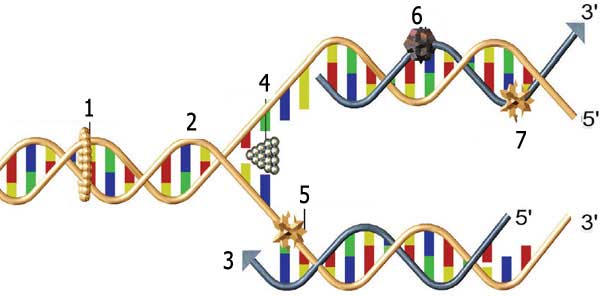 | |
| 1. Topoisomerase | 5. Polymerase |
DNA enzymes are one example that entirely demolishes evolutionist claims of gradual and chance formation, because these enzymes are vitally necessary for DNA to be copied. Yet the information constituting these enzymes is also concealed inside the DNA. Therefore, the presence of DNA is essential for enzymes to come into being; and for enzymes, the prior existence of DNA is essential. The fact that two complex structures have to emerge at exactly the same time is a major difficulty for the theory of evolution, which cannot account for the emergence of either one of them.
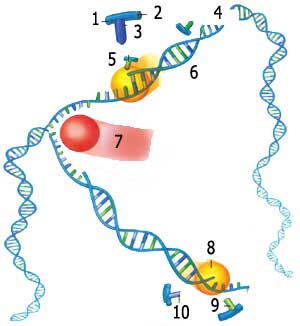 | |
| 1. Sugar | 6. DNA Polymerase |
| The enzymes that enable the production of DNA and also regulate its structure are proteins produced according to the information recorded in DNA, and under its command and control. The DNA must be present if the enzyme is to exist, and the enzyme has to be present for DNA to exist. So magnificent is this system that it's totally impossible for it to have come into being in stages, by chance. | |
This predicament is admitted by the evolutionist scientists Fred Hoyle and Chandra Wickramasinghe:
… Life cannot have had a random beginning. Troops of monkeys thundering away at random on typewriters could not produce the works of Shakespeare, for the practical reason that the whole observable universe is not large enough to contain the necessary monkey hordes, the necessary typewriters, and certainly the waste paper baskets required for the deposition of wrong attempts. The same is true for living material. The likelihood of the spontaneous formation of life from inanimate matter is one to a number with 40,000 noughts after it.. It is big enough to bury Darwin and the whole theory of evolution. There was no primeval soup, neither on this planet nor on any other, and if the beginnings of life were not random, they must therefore have been the product of purposeful intelligence.98
The enzymes that accomplish such difficult tasks are not possessed of consciousness and intelligence. Yet how do these unconscious accumulations of molecules perform actions that require conscious intelligence, such as making decisions, implementing those decisions, possessing foresight, preventing confusion, taking precautions within a flawless order, identifying and rectifying errors and carrying out repairs? The concept of chance, behind which evolutionists hide, loses all significance in the face of such a complex mechanism. Therefore, blind chance definitely constitutes no scientific answer to the question of the origin of life. Anyone of intelligence will agree that conscious, planned processes cannot be performed, one after the other, as the result of chance. The resistance of those who deny the existence of Allah in the face of all the facts is revealed in these terms in the Qur'an:
They said, "No matter what kind of Sign you bring us to bewitch us, we will not believe in you." (Surat al-A'raf, 132)
It is apparent that all the flawless elements in this system must have come into being in a single moment. This means that they have been created. These processes, which human beings find difficult to comprehend even as they read about them, are tasks performed, by Allah's choosing, with enormous ease and success by unconscious atoms at every single moment. In the Qur'an, Allah reveals:
He originates and regenerates. He is the Ever-Forgiving, the All-Loving, the Possessor of the Throne, the All-Glorious, the Doer of whatever He desires. (Surat al-Buruj, 13-16)
Footnotes
88. L. R. Croft, How Life Began, Evangelical Press, İngiltere, 1988, p. 37.
89. Werner Gitt, In the Beginning was Information, , p. 93.
90. http://users.rcn.com/jkimball.ma.ultranet/BiologyPages/D/DNAReplication.html
91. Lee M. Spetner, Not By Chance, Shattering The Modern Theory of Evolution, pp. 38-39.
92. Gerald L. Schroeder, The Hidden Face of God, p. 206.
93. http://en.wikipedia.org/wiki/Enzyme
94. David S. Goodsell, Our Molecular Nature, pp. 40-41.
95. Ibid., p.42.
96. Ibid. pp.39-40.
97. http://users.rcn.com/jkimball.ma.ultranet/BiologyPages/D/DNArepair.html
98. Fred Hoyle, Chandra Wickramasinghe, Evolution from Space, Simon & Schuster, New York, 1984, p. 148.
- From the Depths of the Universe to the DNA Molecule
- The Most Advanced Data Bank Known: DNA
- Aspect of The Cell Discovered In the 20th Century
- The Source of the Data of Life
- The DNA Molecule's Miraculous Structure
- DNA's Extraordinary Data-Storage Capacity
- The Cryptography in the DNA Molecule
- Protein Synthesis: The Matchless Production System Recorded in DNA
- The World's Most Advanced Copying Technology
- The Building Plan Recorded in Human DNA
- Darwinist-Materialist Errors Regarding the Human Genome Project
- The Information in Living Structures and The End of Materialism
- Some of Darwinism's Errors on the Subject of DNA
- How the Miracle of DNA Invalidates the Theory of Evolution
- DNA is an Example of Our Almighty Lord's Creative Artistry
